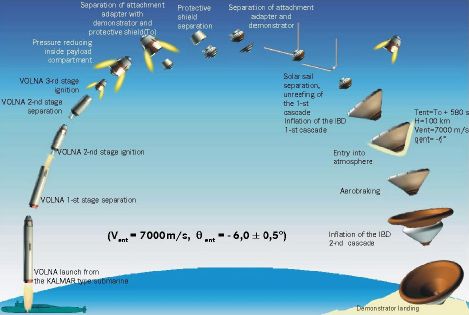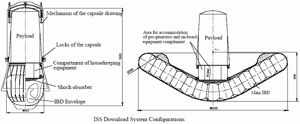
Home - Search - Browse - Alphabetic Index: 0- 1- 2- 3- 4- 5- 6- 7- 8- 9
A- B- C- D- E- F- G- H- I- J- K- L- M- N- O- P- Q- R- S- T- U- V- W- X- Y- Z
IRDT

IRDT
Credit: Astrium
Status: Operational 2000. First Launch: 2000-02-08. Last Launch: 2000-02-08. Number: 1 . Payload: 250 kg (550 lb). Gross mass: 350 kg (770 lb). Height: 1.83 m (5.99 ft). Diameter: 0.52 m (1.70 ft). Span: 2.50 m (8.20 ft).
Tested three times since 2000, with only one partially successful recovery.
An inflatable re-entry and descent technology (IRDT) Mars re-entry vehicle was developed by Lavochkin and was to have been first demonstrated on the Mars-96 mission. However the spacecraft failed to leave earth orbit to an upper stage failure. In 1998 Lavochkin and DASA agreed to jointly develop and marketing of the IRDT for earth orbit applications. A first test flight of an IRDT Demonstrator was in 2000. The spacecraft completed six orbits of the earth and (after some delay) was located and recovered southwest of the city of Orenburg, Russia. The Demonstrator included a 100 kg vehicle consisting of the inflatable IRDT system, the associated service system (gas supply and regulation, control electronics), and a performance measurement package with an inertial measuring unit, temperature and gas sensors.
In 2001 it was decided to conduct a second test flight and proceed with detail design of an operational ISS Download System.
The Inflatable Reentry and Descent Technology approach was designed to replace heavier, hard-shell re-entry vehicles traditionally used. The IRDT system consisted of three main subsystem elements: a Thermal Protection System (TPS) for reentry; a Parachute System for descent to the earth's surface; and a damping/floatation system for a soft landing at sea or on the ground. The inflatable material was densely packed during the launch and orbit phases, allowing the re-entry vehicle to be packaged in smaller volumes and diameters then a conventional system. Following the mission in earth orbit, the IRDT was de-orbited by either an attached upper stage or its own de-orbit motor. Prior to entering the upper layers of the atmosphere, the re-entry shield of the IRDT device would be inflated through a pyrotechnic valve from either cold gas storage tanks or a gas generator. The inflatable braking shield consisted of multiple layers of insulation and flexible ablative material over the inflatable core. This inflated shield had the proper shape to protect and brake the payload in the re-entry phase from Mach 22 to subsonic speed. A second ring was inflated at 25 km altitude to further brake the IRDT from subsonic speed to a final descent speed of 10 m/s. If necessary, for human or other fragile cargo, a further braking/shock attenuation system could be added for final touchdown.
The IRDT-2 Demonstrator was designed for suborbital launch from a submarine using a surplus ballistic missile. The IRDT-2 incorporated improvements in the shield design based on the results of the first mission, a revised internal pressure control and monitoring system, a telemetry system for the landing phase, and an improved sensor package to provide flight evaluation data. The IRDT-2 would be launched to 7000 m/s entry velocity and a -6 deg entry angle (considered representative for orbital entry conditions of 7800 m/s and a -2 deg angle). The total mass of IRDT-2 was 140 kg. Unlike planned operations systems, the braking system included an ablative rigid nose. The spacecraft included a COSPAS-SARSAT satellite radio search system to aid in location of the spacecraft after landing. IRDT-2 would be launched from the Barents Sea near Murmansk and land on the Kamchatka Peninsula (taking advantage of the Russian tracking range for ballistic missile tests).
Unfortunately two launches of the IRDT-2 both ended in failure, in that the vehicle could not be located after re-entry and its ultimate fate and effectiveness remained unknown.
An IRDT-based ISS Download System was sized for delivery to the ISS by Russian Progress or European ATV unmanned station resupply vehicles. The ISS docking port diameter of 800 mm was the major constraint in sizing the system. The ISS Download System could return a payload of 300 liters volume, and 200 - 250 kg mass, while having an empty mass itself of 100 kg. Prior to departure of the ATV or Progress, the IRDT would be would be loaded with payload, prepared for flight, and mounted in the docking ring of the ATV or Progress. Once the cargo ship undocked from the station and made a de-orbit burn, the capsule would be jettisoned. Landing would take place in the standard Russian recovery zone in Kazakhstan.
Due to the two subsequent failures of the IRDT-2, there were no announced plans to proceed with an operational ISS system (although this may have been attractive after troubles with the shuttle sharply limited the payload that could be returned from the station). There also seems to have been little interest in using a version of the system as a manned bail-out system (such as the similar General Electric MOOSE of the 1960's).
Family: Space station orbit, Technology. Country: Russia. Launch Vehicles: R-7, Soyuz-U, Soyuz-U-PVB. Launch Sites: Baikonur, Baikonur LC31. Agency: Lavochkin bureau. Bibliography: 2, 552, 554.
 | IRDT Credit: Astrium |
 | ISS IRDT Credit: Astrium |
 | IRDT-Fregat Credit: Manufacturer Image |
 | IRDT Credit: Manufacturer Image |
2000 February 8 - . 23:20 GMT - . Launch Site: Baikonur. Launch Complex: Baikonur LC31. LV Family: R-7. Launch Vehicle: Soyuz-U-PVB.
- IRDT - .
Mass: 110 kg (240 lb). Nation: Russia.
Agency: ESA.
Manufacturer: Lavochkin bureau.
Class: Technology.
Type: Re-entry test vehicle. Spacecraft Bus: Rescue.
Spacecraft: IRDT.
COSPAR: 2000-009x. Apogee: 613 km (381 mi). Perigee: 580 km (361 mi). Inclination: 64.85 deg. Period: 96.53 min.
After four orbits around the Earth the test vehicle was powered by the launcher's upper stage to re-enter the atmosphere for a landing about 1800 km northwest of the launch site. The heat shield was inflated and the IRDT separated from the upper stage. It then passed through the upper atmospheric layers that imposed the highest dynamic pressure, heat flux and acceleration loads onto the system. The IRDT landed inside the predicted area at 54 deg E and 51 deg N near the Kazakhstan border. Unfortunately, a tear occurred in the inflatable shield during descent resulting in a higher velocity and a heavier than expected impact on landing, resulting in some damage to the lower part of the IRDT. The IRDT was collected by helicopter so that the memory unit of the sensor package, with all recorded data, could be analysed. An initial data check confirmed that all experiments in the sensor package worked perfectly.
Back to top of page
Home - Search - Browse - Alphabetic Index: 0- 1- 2- 3- 4- 5- 6- 7- 8- 9
A- B- C- D- E- F- G- H- I- J- K- L- M- N- O- P- Q- R- S- T- U- V- W- X- Y- Z
© 1997-2019 Mark Wade - Contact
© / Conditions for Use